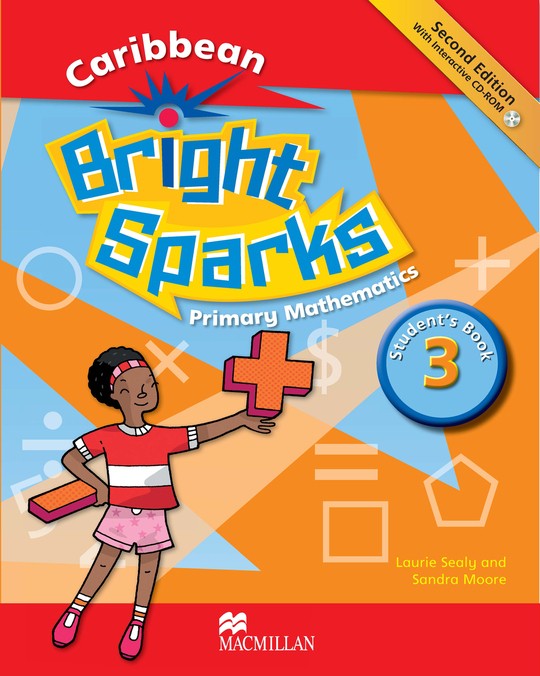
Bright Sparks Level 5 Student's Book
US$ 14.78
The publisher has enabled DRM protection, which means that you need to use the BookFusion iOS, Android or Web app to read this eBook. This eBook cannot be used outside of the BookFusion platform.
Description
Contents
Reviews
Language
English
ISBN
9780230465176
Cover
Title
Copyright
Contents
Scope and sequence
How to use Bright Sparks – for students
Introduction – for teachers
How to use this CD-ROM
Unit 1: Number
1.1 Place value
1.2 Value
1.3 Expanded form
1.4 More expanded numbers with regrouping
1.5 Strategy: Forming numbers
Assessment 1
Unit 2: Patterns, sequence and order
2.1 Ordering numbers
2.2 Counting and ordering
2.3 Problem solving
2.4 Patterns
2.5 Revision
Unit 1 and Unit 2 check and summary
Unit 3: Operations – addition and subtraction
3.1 Estimation skills
3.2 Properties of addition
3.3 Addition with regrouping
3.4 Adding large numbers
3.5 Subtraction practice
3.6 Subtracting large numbers
3.7 Regrouping with zeros
3.8 Adding and subtracting money
3.9 Subtraction practice
Unit 3 check and summary
Assessment 2
Unit 4: Decimals
4.1 Types of numbers
4.2 Tenths
4.3 Place value: hundredths
4.4 Decimals and whole numbers
4.5 Rounding decimals
4.6 Value
4.7 Ordering and comparing decimals
4.8 Rounding and estimating decimals
4.9 Addition and subtraction of decimal numbers
4.10 Problem solving
4.11 Group project: A new computer
Unit 4 check and summary
Assessment 3
Unit 5: Multiplication
5.1 Multiples
5.2 Multiplication speed tests
5.3 Arrays
5.4 Square numbers
5.5 Square roots
5.6 Problem solving: Mental computation
5.7 Multiplying large numbers mentally
5.8 Multiplying 3-digit numbers
5.9 Multiplying large numbers
5.10 Multiplying by multiples of 10
5.11 Multiplying by 2-digit numbers
5.12 Problem solving
5.13 Multiplication practice
Unit 5 check and summary
Assessment 4
Unit 6: Division
6.1 Factors
6.2 Divisibility
6.3 Division: review
6.4 Using opposites: multiplication and division
6.5 Division speed tests
6.6 Division with remainders: review
6.7 Dividing larger numbers
6.8 Problem solving
6.9 Division using zeros
6.10 Using long division and zeros
6.11 Division with money
6.12 Using a calculator
6.13 Dividing by 2-digit numbers
6.14 Problem solving
6.15 Long division practice
Unit 6 check and summary
Assessment 5
Unit 7: Fractions
7.1 Least (Lowest) Common Multiple
7.2 Greatest Common Factor (GCF) / Highest Common Factor (HCF)
7.3 Prime factors
7.4 Common fractions (or proper fractions)
7.5 Adding fractions
7.6 Decimals and fractions
7.7 Equivalent fractions
7.8 Reducing fractions to their simplest form
7.9 Estimating fractions
7.10 Improper fractions and mixed numbers
7.11 Equivalent fractions
7.12 Comparing fractions
7.13 Adding fractions
7.14 Subtracting fractions: review
7.15 Subtracting fractions with unlike denominators
7.16 Estimating and problem solving
7.17 Mixed numbers
7.18 Subtracting mixed numbers
7.19 Problem solving
7.20 Practice
7.21 Enrichment: Cross multiplication
7.22 Working with calculators
Unit 7 check and summary
Assessment 6
Unit 8: Geometry
8.1 Lines
8.2 Angles
8.3 Measurement of angles
8.4 Triangles
8.5 Polygons
8.6 Naming plane (2D) shapes
8.7 Describing movement
8.8 Circles: review
8.9 Symmetry
8.10 Solid (3D) shapes: review
8.11 Making nets
8.12 Coordinates
8.13 Perimeter: Review
8.14 Perimeter problem solving
8.15 Area and perimeter: review
8.16 Calculating area
8.17 More area problems
8.18 Enrichment: Area of irregular shapes
8.19 Area of triangles
8.20 Volume
Unit 8 check and summary
Assessment 7
Unit 9: More decimals
9.1 Multiplying decimal numbers
9.2 Division by a whole number
9.3 Adding zeros to the dividend
9.4 Multiplying and dividing decimals by 10, 100, 1000
9.5 Enrichment: SI, the metric system
9.6 Metric conversions
Unit 9 check and summary
Unit 10: Measurement
10.1 Units of length
10.2 Longer lengths: review
10.3 Working with units of length
10.4 Practice with longer units of length
10.5 Mass
10.6 Converting between units of mass
10.7 Capacity: review
10.8 Converting between units of capacity
10.9 Mixed units
10.10 Problem solving: different units of measurement
Unit 10 check and summary
Unit 11: More fractions
11.1 Multiplying fractions
11.2 Multiplying whole numbers and mixed numbers by fractions
11.3 Cancelling
11.4 Drawing a sketch
11.5 Dividing fractions
11.6 Mixed multiplication and division of fractions
11.7 Mixed problem solving
11.8 Teamwork: Measurement game
Unit 11 check and summary
Assessment 8
Unit 12: Percent, ratio and proportion
12.1 Percent
12.2 Percent and decimals
12.3 Percent, decimals, and fractions
12.4 Finding the percent of an amount
12.5 Problem solving
12.6 Comparing fractions
12.7 Practice with percent
12.8 Activity: Dominoes game
12.9 Discount
12.10 Problem solving
12.11 Wages and salaries
12.12 Simple interest
12.13 Ratio
12.14 Simplifying ratios
12.15 Proportion
12.16 Working with scale
12.17 Problem solving: fractions, ratios and percents
Unit 12 check and summary
Assessment 9
Unit 13: Measurement – time
13.1 Review
13.2 Enrichment: 24-hour system
13.13 Calculating elapsed time
Unit 14: Statistics, data and probability
14.1 Finding the mean
14.2 Working with the total
14.3 Interpreting data and drawing graphs
14.4 Making graphs / frequency charts
14.5 Enrichment: Interpreting data with a line graph
14.6 Circle graphs (pie charts)
14.7 Interpreting the circle graph
14.8 Using percentages in circle graphs
14.9 Probability
14.10 Enrichment: Introduction to sets
14.11 Enrichment: Types of sets
14.12 Displaying data in Venn diagrams
14.13 Practice with sets
Unit 13 and Unit 14 check and summary
Assessment 10
Final assessment 1
Final assessment 2
Final assessment 3
Index
Back Cover
The book hasn't received reviews yet.











